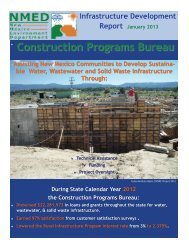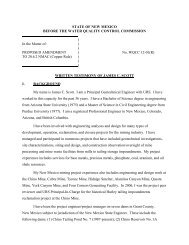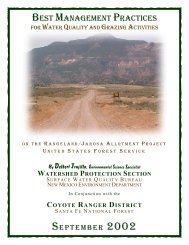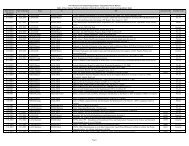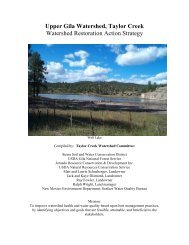Surface and Precipitation Stations - New Mexico Environment ...
Surface and Precipitation Stations - New Mexico Environment ...
Surface and Precipitation Stations - New Mexico Environment ...
You also want an ePaper? Increase the reach of your titles
YUMPU automatically turns print PDFs into web optimized ePapers that Google loves.
• All particulate modeling will be performed using 1 gram per second nominal emission rates<br />
in CALPUFF for the specific size ranges presented in the NPS speciation spreadsheets (i.e.,<br />
PM8.0, PM4.25, PM1.88, PM1.25, PM0.813, <strong>and</strong> PM0.625). These modeled species will be grouped<br />
in POSTUTIL as to represent the appropriate visibility pollutants (e.g., PMcourse = PM8.0 +<br />
PM4.25 <strong>and</strong> PMfine = PM1.88 + PM1.25 + PM0.813 + PM0.625) <strong>and</strong> will be scaled with the<br />
emission rates derived from the NPS spreadsheets. EC <strong>and</strong> SOA will be derived from the<br />
PM1.88 species <strong>and</strong> scaled with the emission rates derived from the NPS spreadsheets.<br />
2.2.1.1 H2SO4 (SO4) Emissions<br />
Condensable PM10 will be subdivided into inorganic <strong>and</strong> organic compounds using the NPS<br />
speciation spreadsheets. The inorganic portion is by default assumed to be H2SO4 <strong>and</strong> will me<br />
modeled as SO4. The organic portion will be modeled as secondary organic aerosols (SOA).<br />
2.2.2 Post Control Modeling<br />
As required by EPA guidance, each technically feasible BART control technology must be assessed<br />
to determine the degree of visibility improvement. These relative improvements from various<br />
technologies <strong>and</strong>/or control levels can then be factored into the BART decision. At this time, the<br />
evaluation of technically feasible controls (Step 4 of the BART process) has not been completed <strong>and</strong><br />
it is unknown how many feasible control technologies options are available for consideration.<br />
However once determined, each technically feasible control for each pollutant will be modeled on a<br />
unit by unit basis.<br />
For the purpose of this PNM Protocol NOx <strong>and</strong> PM10 are the only pollutants subject to BART<br />
analyses. Due <strong>New</strong> <strong>Mexico</strong> participating in a trading program for SO2, a SO2 BART analysis is not<br />
required <strong>and</strong> will not be modeled as a separate feasible control technology option. However, SO2<br />
emissions will be included as a modeled pollutant as part of both the baseline <strong>and</strong> post control<br />
modeling scenarios. PM10 emissions will be speciated as described in the baseline modeling section.<br />
The stack parameters <strong>and</strong> emission rates used for the post control modeling for each unit, pollutant,<br />
<strong>and</strong> technology will be determined <strong>and</strong> presented in the final report submitted to NMED.<br />
2.3 Model Versions<br />
The versions of the CALPUFF modeling system suggested in the WRAP Protocol <strong>and</strong> used by<br />
WRAP RMC for the initial modeling will be used for these modeling analyses <strong>and</strong> are listed in Table<br />
2-3.<br />
2-6 4/13/2007



